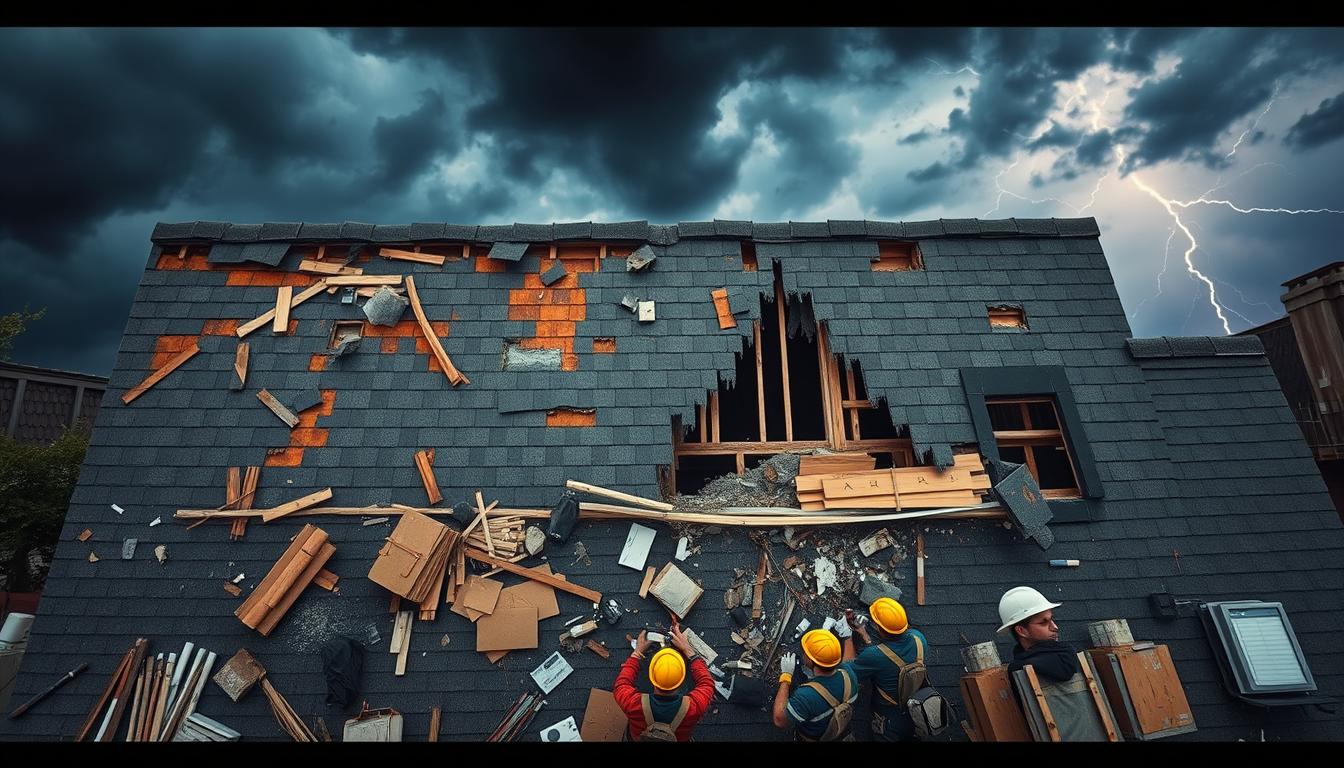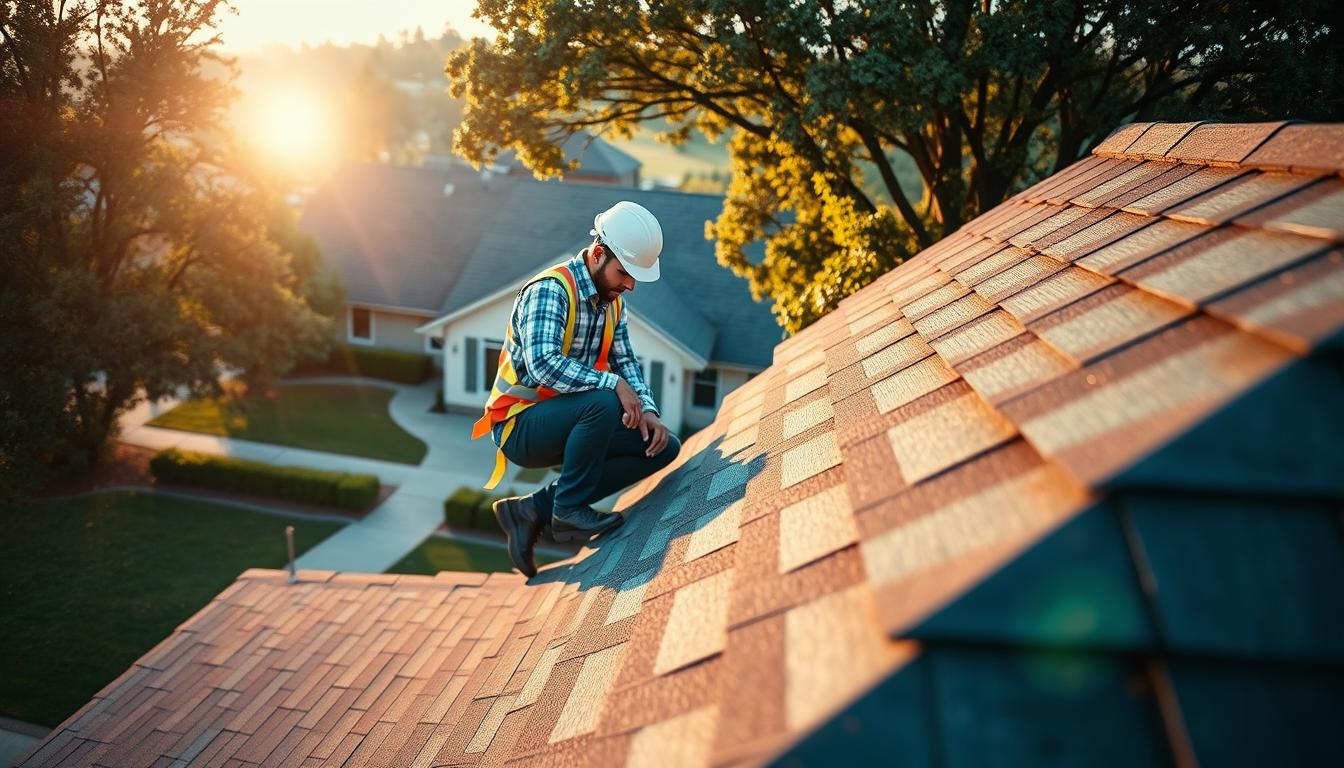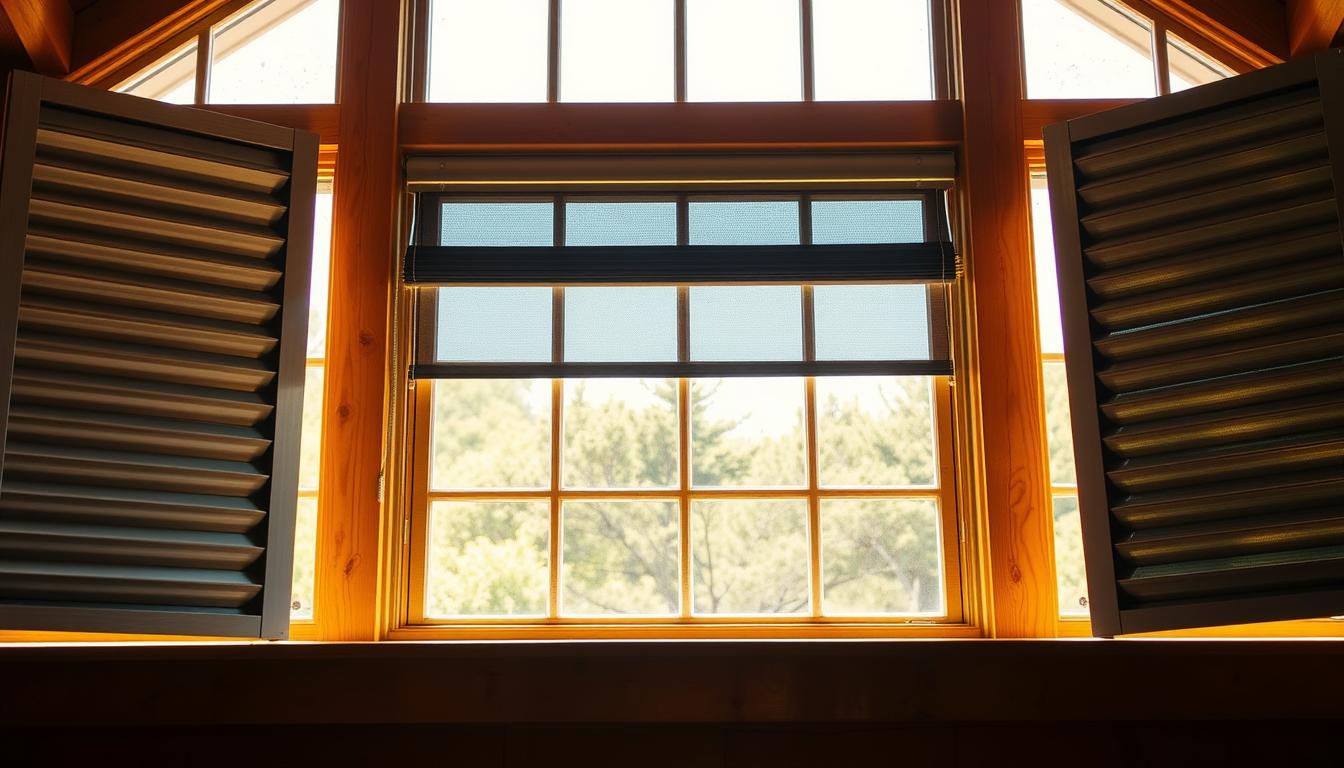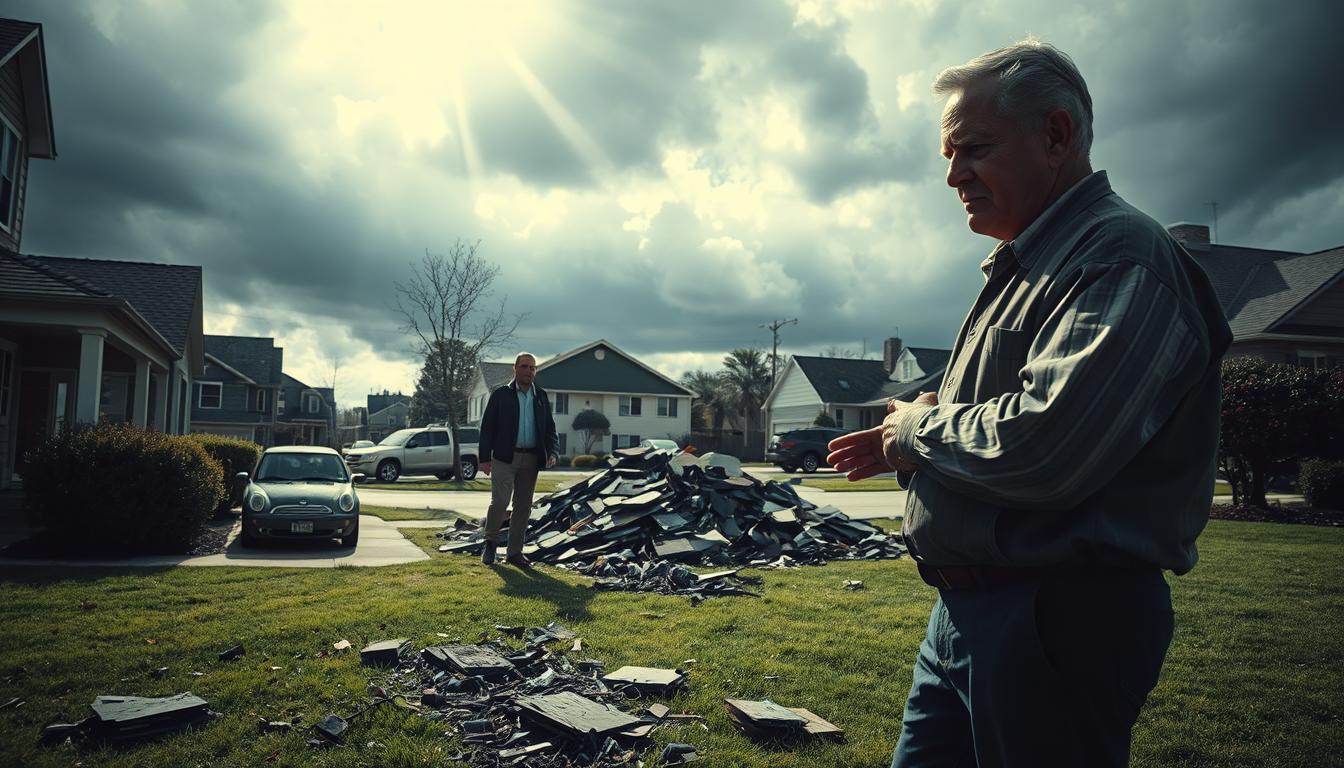Severe storms can cause a lot of damage to roofs. The Rich Co Inc knows how tough it is to fix roofs in Colorado Springs. Since 70% of homes get damaged during bad weather, it’s key to know how to repair or replace roofs.
Figuring out how to fix your roof after a storm can be tough. But, getting help from experts makes a big difference. It’s important to act fast to avoid more damage and keep your home safe.
Storms can hurt your roof in ways you might not see right away. Roofing pros say you should act quickly to avoid bigger problems later. This way, your home stays safe and sound.
Key Takeaways
- 70% of homeowners face roof damage after severe storms
- Immediate professional assessment is critical
- DIY repairs can risk insurance coverage
- Documentation is essential for insurance claims
- Professional roof restoration prevents further damage
- Timely repairs can save significant repair costs
- Regular roof maintenance prevents extensive storm damage
Immediate Safety Measures and Damage Assessment
Storm damage to your roof can be overwhelming and dangerous. It’s key to know how to assess it safely. About 70% of homeowners face roof leaks after severe weather, so a careful approach is vital.
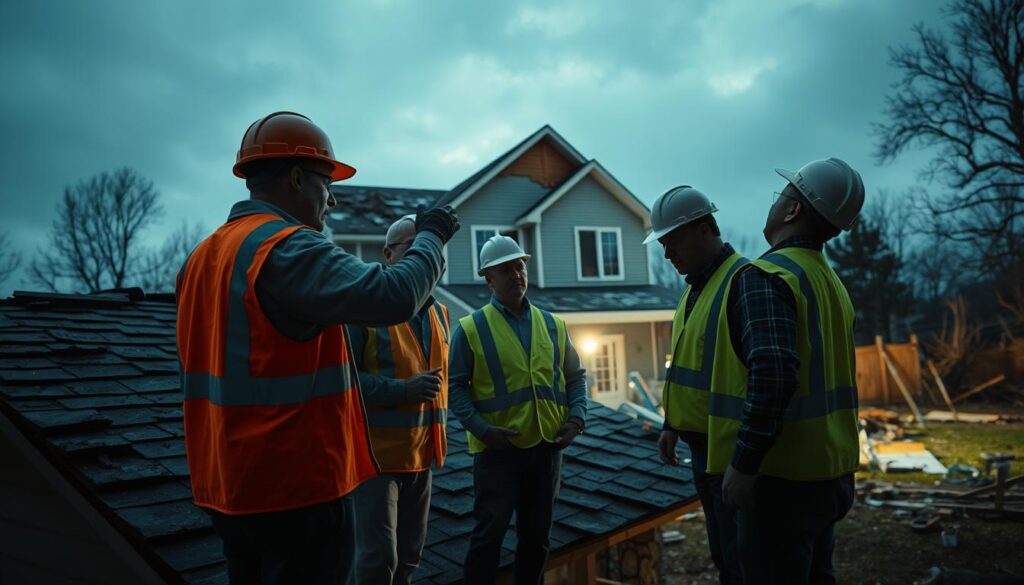
After the storm, your main goal is to inspect the roof safely. Roofing experts say to stay on the ground to avoid accidents.
Visual Inspection from Ground Level
Here’s how to do a safe roof check:
- Use binoculars to look at the roof from a safe spot
- Search for damage like:
- Missing or curled shingles
- Fallen debris
- Potential leak spots
- Look for any structural issues without climbing
Documentation Requirements
Good documentation is key for fixing leaks and insurance claims. Take clear, detailed photos of any damage. Doing this can boost your insurance claim success by up to 50%.
Safety Precautions During Assessment
Always put your safety first when checking for damage. Don’t climb on the roof if you think it’s damaged. For a safe check, call a certified roofing contractor.
If you need help fast, call The Rich Co Inc at (719) 287-5385. They offer expert roof inspections and damage checks.
Understanding Storm Damage Signs on Your Roof
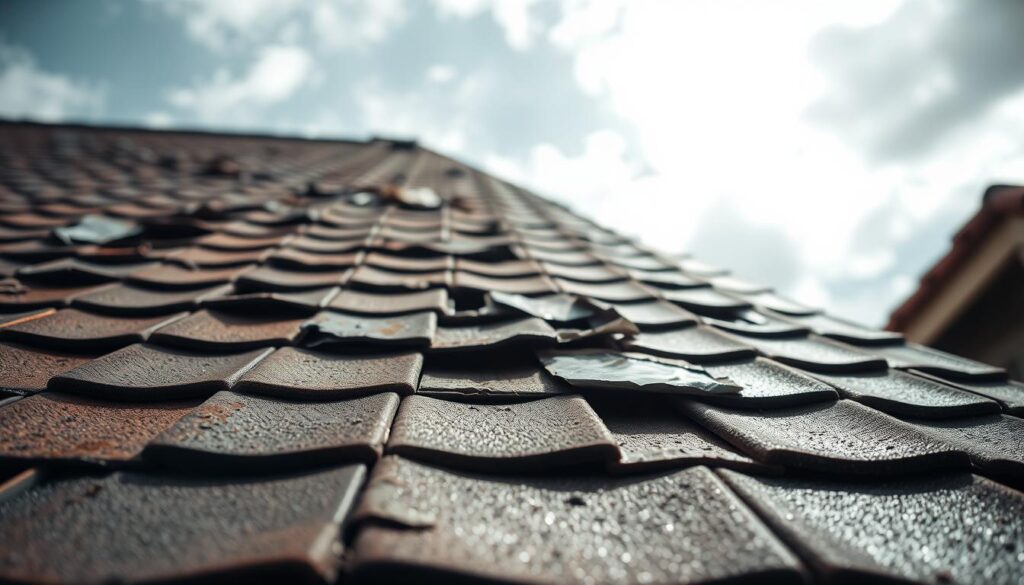
Spotting storm damage early is key for roof upkeep. Severe weather can seriously harm your roof. This could lead to expensive fixes if not caught soon.
Homeowners need to watch for storm damage signs. These signs can stop damage from getting worse. They also keep your home’s structure safe.
- Missing or curled roof shingles that expose underlying materials
- Granule accumulation in gutters, signaling potential roof shingle replacement needs
- Visible dents in metal components like vents and flashing
- Water stains on interior ceilings or walls
- Unexpected leaks during rainfall
Experts say up to 80% of storm damage is hidden. About 60% of homeowners face roof damage after storms. Quick checks are vital.
Wind, hail, and debris can cause big problems. High winds can knock off shingles. Hail can dent your roof, making it less effective. Even small holes from branches can let in a lot of water.
After storms, keeping your roof in good shape is crucial. Inspect your roof within 24 to 48 hours. This can save you thousands and make your roof last 10 to 15 years longer.
The Roof Restoration Process After Storm Damage
Storm damage can quickly turn your roof from a strong shield to a weak spot. It’s vital to get professional help to stop more damage and keep your home safe.
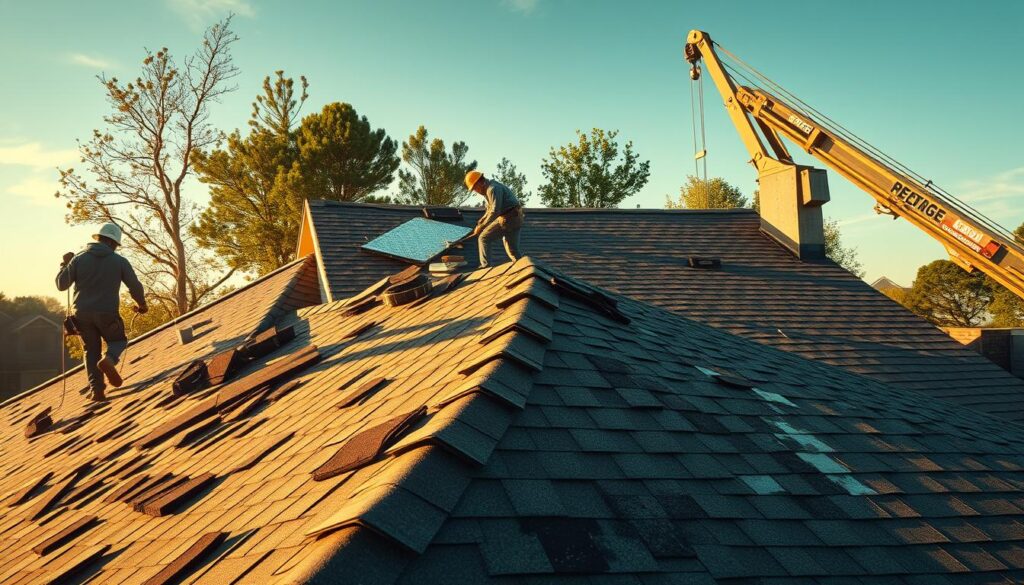
Emergency Temporary Solutions
When a storm hits, quick action is key to avoid big problems. Homeowners should take these important steps:
- Apply waterproof tarps to cover exposed areas
- Remove debris that might cause additional roof damage
- Block water entry points with professional-grade sealants
About 80% of homeowners don’t use emergency fixes right, leading to big structural issues.
Professional Inspection Steps
A thorough roof check is essential after a storm. Experts usually follow these steps:
- Do a detailed visual check
- Use advanced tools to find hidden damage
- Check if roof coating and cleaning are needed
- Document all damage for insurance
Almost 70% of roof problems can’t be seen from the ground. This shows why professional cleaning and checks are so important.
Restoration Timeline Planning
Having a solid repair plan helps manage the work well. Important things to think about include:
- Focus on the most urgent repairs
- Plan roof cleaning to stop mold
- Figure out how long repairs will take and what they’ll cost
- Work with insurance companies
Act fast: Every day you wait can add 10-20% to damage and repair costs.
Insurance Claims and Documentation Requirements
Dealing with insurance claims after a storm can be tough. Knowing the right steps is key. It helps homeowners protect their homes and get the roof ventilation fixed right.
When you file a claim for roof damage, having the right documents is essential. Here are the main steps:
- Take detailed photos of all storm damage
- Document damage both inside and outside
- Get close-up and wide shots of the roof damage
- Save any evidence of roof ventilation problems
Most insurance plans cover roof repairs. The coverage usually falls into two types:
- Repair Coverage: Pays a part of the repair costs
- Replacement Coverage: Covers the full cost of a new roof
The insurance claim process has important steps:
- Call your insurance company right after you find damage
- Get a professional roof check (takes 1-2 days)
- Wait for the insurance adjuster to visit (1-2 weeks)
- Get your first insurance check within 2 weeks after approval
Getting a professional roof check is crucial for accurate damage reports. Experts say getting several repair quotes is a good idea. It helps make sure you get fair compensation and full coverage.
Professional Restoration Services and Repairs
Storm damage can really hurt your roof. This makes getting professional help very important. Knowing how to fix your roof right can save you a lot of time and money.
Choosing a Qualified Contractor
Finding the right roof repair expert is key. You should look for someone who:
- Has the right state license and insurance
- Has done many successful roof repairs
- Has good reviews from customers
- Knows how to handle local weather issues

Material Selection Process
Choosing the right materials for your roof is important. You should pick materials that:
- Last long in your local weather
- Save energy
- Are cost-effective over time
- Look good with your home
Quality Control Measures
Good roof repair means following strict quality rules. Top-notch services do detailed checks to make sure:
- They find all the damage
- They use the right materials
- Seams and holes are sealed well
- The roof is strong at the end
Getting professional roof repair can add 10 to 15 years to your roof’s life. It can also make your home 5% to 15% more valuable and save up to 20% on energy costs.
Preventing Future Storm Damage
To keep your roof safe from storm damage, you need to take care of it and plan ahead. Regular roof checks can spot problems early. This can save you a lot of money on repairs later on.
Trimming tree branches that hang over your roof is a smart move. It helps prevent damage from strong winds. Keeping your gutters clean is also important. Too many granules can mean your shingles are wearing out.
Using shingles that can handle hail and wind is another good idea. It can cut down storm damage by up to 30%. This makes your roof stronger against bad weather.
Getting your roof checked by a pro is key to avoiding damage. Experts say you should do this twice a year, in spring and fall. They can find problems you might not see, like 60% of homeowners do.
By taking care of your roof and using the right materials, you can protect your home. This way, you can feel safe when the weather gets rough.

